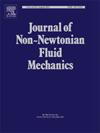Pressure drop reduction due to coupling between shear-thinning fluid flow and a weakly deformable channel wall: A reciprocal theorem approach
IF 2.8
2区 工程技术
Q2 MECHANICS
引用次数: 0
Abstract
We employ the Lorentz reciprocal theorem to derive a closed-form expression for the pressure drop reduction due to the coupling between shear-thinning fluid flow and a weakly deformable channel wall in terms of the shear rate and the viscosity function (and its derivative) of the underlying rigid-channel flow. The methodology is applied in parallel to fluids for which the generalized Newtonian viscosity depends on either the shear rate or the shear stress magnitude. When the viscosity model allows for a closed-form solution for the axial velocity profile in a straight and rigid channel, the pressure drop reduction can be evaluated in closed form, which we demonstrate for the power-law and Ellis viscosity models as featured examples and to enable comparisons to previous works. Importantly, the pressure drop reduction under the Ellis model is valid for both small and large Carreau (or Ellis) numbers, and we show that it reduces to the analytical expression under the power-law model for large Carreau (small Ellis) numbers.
由于剪切变薄流体流动和弱变形通道壁之间的耦合导致的压降降低:一个互反定理方法
我们采用洛伦兹互易定理,根据剪切变薄流体流动和弱变形通道壁面之间的耦合,根据底层刚性通道流动的剪切速率和粘度函数(及其导数),推导出压降减小的封闭表达式。该方法同时适用于广义牛顿粘度取决于剪切速率或剪切应力大小的流体。当粘度模型允许在直线和刚性通道中轴向速度分布的封闭形式解时,压降减少可以以封闭形式进行评估,我们将幂律和Ellis粘度模型作为特色示例进行了演示,并与以前的工作进行了比较。重要的是,Ellis模型下的压降减小对大小carcarau(或Ellis)数都有效,并且我们证明了它在幂律模型下对大carcarau(或Ellis)数的解析表达式。
本文章由计算机程序翻译,如有差异,请以英文原文为准。
求助全文
约1分钟内获得全文
求助全文
来源期刊
CiteScore
5.00
自引率
19.40%
发文量
109
审稿时长
61 days
期刊介绍:
The Journal of Non-Newtonian Fluid Mechanics publishes research on flowing soft matter systems. Submissions in all areas of flowing complex fluids are welcomed, including polymer melts and solutions, suspensions, colloids, surfactant solutions, biological fluids, gels, liquid crystals and granular materials. Flow problems relevant to microfluidics, lab-on-a-chip, nanofluidics, biological flows, geophysical flows, industrial processes and other applications are of interest.
Subjects considered suitable for the journal include the following (not necessarily in order of importance):
Theoretical, computational and experimental studies of naturally or technologically relevant flow problems where the non-Newtonian nature of the fluid is important in determining the character of the flow. We seek in particular studies that lend mechanistic insight into flow behavior in complex fluids or highlight flow phenomena unique to complex fluids. Examples include
Instabilities, unsteady and turbulent or chaotic flow characteristics in non-Newtonian fluids,
Multiphase flows involving complex fluids,
Problems involving transport phenomena such as heat and mass transfer and mixing, to the extent that the non-Newtonian flow behavior is central to the transport phenomena,
Novel flow situations that suggest the need for further theoretical study,
Practical situations of flow that are in need of systematic theoretical and experimental research. Such issues and developments commonly arise, for example, in the polymer processing, petroleum, pharmaceutical, biomedical and consumer product industries.

 求助内容:
求助内容: 应助结果提醒方式:
应助结果提醒方式:


